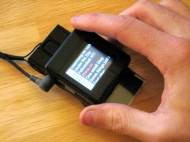Minput provides low-cost and high-precision pointing for gadgets
 By installing a pair of optical sensors on the back of a mobile phone or mp3 player, the researchers at Carnegie Mellon University found that the entire device could have many of the same benefits as that of a computer mouse when the device was placed against a surface, a piece of clothing or the palm of a hand. This new input method, called Minput, responds to up-down, and side-to-side motions, as well as to twisting and flicking motions.
By installing a pair of optical sensors on the back of a mobile phone or mp3 player, the researchers at Carnegie Mellon University found that the entire device could have many of the same benefits as that of a computer mouse when the device was placed against a surface, a piece of clothing or the palm of a hand. This new input method, called Minput, responds to up-down, and side-to-side motions, as well as to twisting and flicking motions.
“Minput turns out to be a fairly intuitive way to navigate through menus or photo galleries on a device’s display without fumbling with tiny buttons or obscuring a small touchscreen with your fingers,” said Chris Harrison, a third-year Ph.D. student who developed the method with his faculty adviser, HCII Professor Scott Hudson. “Because we use a pair of sensors, it can respond to a wide range of gestural commands, much like an iPhone or other multi-touch device.”
Twisting a Minput-equipped device might allow a user to zoom in or out of a photo or document, while flicking the device against a surface enables the user, for instance, to switch between photos or between photo galleries. Minput also permits high-precision positioning (such as selecting a sentence of text from a paragraph) that would be difficult to perform on a small touchscreen or with other types of gestural input, where the size of the finger might occupy a majority of the screen.
Minput didn’t require developing any new sensor technology, Harrison said. “The hard part was done for us; optical sensors are already fantastically well-engineered. And at about a dollar apiece, they wouldn’t add much to the cost of a mobile phone or music player,” he noted. “We just use these sensors in a new and clever way.”
For their prototype, Harrison and Hudson mounted two optical sensors on the back of a wristwatch-size television with a 1.5-inch-diagonal display. Computer processing is performed off-board by a laptop computer. But Harrison said the Minput sensors and processors could be readily miniaturized to fit inside small mobile devices.
In order to get a preliminary understanding of the sensitivity and usability of their approach, Minput prototype was presented to eight beta testers (four female, mean age 23.1) who had not seen or used the device. The testers were allowed to play with each application, including the music player, photo album browser, single photo navigation with zoom, photo grid navigation with zoom, and mock webpage navigation.
During the session, users were encouraged to provide commentary on their impressions. Verbal instructions were given when needed in order to help users operate the applications. Reactions were overwhelmingly positive. People consistently used words like “natural” and “intuitive” to describe the interactions, with several noting that they “understand completely how to use it” within a few minutes of using the prototype device.
Since it is intuitive and it offers similar abilities as considerably more sophisticated systems, but for a fraction of the cost and complexity, we wouldn’t be surprised if we see this technology in miniaturized gadgets of the future. For more info, you can read a paper named: Minput: Enabling Interaction on Small Mobile Devices with High-Precision, Low-Cost, Multipoint Optical Tracking (PDF).









Wow, this stuff is great!